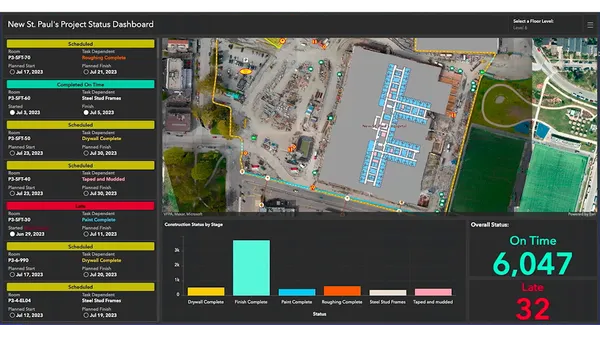Construction remains one of the top five industries driving the world economy. Yet until recently, it’s been lagging behind virtually every other sector in the adoption of technology.
In this in-depth interview, Dr. Dan Patterson, Chief Design Officer with InEight, explains why the construction industry is now turning to technology solutions that utilize artificial intelligence (AI) to solve long standing and deep-rooted challenges.
Q: Can a traditional industry such as construction embrace technology quickly enough to take advantage of platforms such as artificial intelligence?
DP: Historically, the construction industry has lagged in its adoption of new technology. That trend is changing, however, with construction companies moving towards digital solutions to solve common project challenges and improve outcomes. A lot of that investment is taking place specifically around AI, with a recent report forecasting the construction industry spending over four billion dollars in AI by 2026.
Construction projects are inherently complex, with lots of moving parts. While there is a perception that the focus should be on execution, the reality is that project success is actually more dependent on sound upfront planning. This is an area where AI is making a significant difference.
Project planning is essentially forecasting future events and spend. With the advent of AI, this planning process can now take advantage of the huge amounts of historical productivity and as-built performance data that was previously too complex to mine through to help influence the forecast being put together.
Planning, and specifically scheduling, tend to be very labor-intensive processes. AI is also helping here. Scheduling tools are now starting to assist in the planning process by making informed suggestions as to what durations, sequence and cost of work should be. That is a pretty amazing breakthrough and arguably the most interesting step forward in critical path method, or CPM, scheduling in the last 20 years.
Q: What challenges are the construction and engineering industries facing with respect to digitalization?
DP: I usually focus my attention on the data aspect of digital transformation. To me, the digitization of analog data is actually quite straightforward. What is difficult, though, is making sense of the digitized information once you’ve captured it. Construction data tends to be unstructured. For that information to be useful, we need to properly categorize and tag huge volumes of historical data so it can be used intelligently.
If you think about it, having thousands of historical as-built schedules in a database doesn’t really help a project planner. Conversely, having the computer determine trends from those as-built schedules helps the planner determine what productivity rates ought to be when putting together new plans.
To add to the challenge, what if the historical information captured as a digital asset is out of date, or perhaps not relevant anymore? In such cases, we need to adjust and update the information.
Machine learning can help here. If a user pushes back on, say, a given suggestion based on historical trends, the computer should be smart enough to recognize that pushback and adjust its data accordingly.
Q: InEight’s planning, scheduling and risk solution combines both human and artificial intelligence. Do you see the role of human intelligence (HI) being scaled back as the algorithms learn? Or will there always be a significant role for HI?
DP: HI and AI are equally important. Think of AI as the calibrating engine – it helps adjust a project plan or schedule in accordance with what has been achievable historically. While useful, shouldn’t there be a mechanism for doing a validation on this?
This is exactly where HI comes into play. Having multiple stakeholders, such as discipline leads or field personnel, actually validate and buy into what has been established in the schedule is key. Without this, the schedule is little more than the planner’s best guess. With such buy-in, though, you have a much higher overall degree of certainty and realism in the schedule. The greater the certainty, the greater the chance of on-time delivery.
So, AI will never replace the human factor. In fact, I believe it shouldn’t be called ‘artificial’ Intelligence, but rather, ‘augmented’ intelligence. AI assists in the project planning process – it doesn’t replace it.
Q: Team and management buy-in is incredibly important in construction project planning. What technology solutions can get stakeholders involved to contribute positively to the planning process?
DP: This has always been a massive challenge, and I think it’s because planning and scheduling tools are inherently very complex. The tools that have been developed to help with planning have been targeted at planners, not team members. The key to changing this is simplicity. We need to give team members very simple interfaces that don’t require extensive training on the likes of CPM scheduling.
One approach we’ve found to be very effective is the use of ‘voting.’ Having team members simply vote on the realism of, say, durations and sequence of work in a schedule is a much more intuitive means for a contributor to give feedback than expecting them to walk through a complex Gantt-based approach. Adopting a voting process also allows us to then understand trends such as consensus and the range of differing opinions.
Q: Is a shorter planning phase – albeit one aided by technology – necessarily a good thing?
DP: No! Firstly, it’s a bit of a misperception that the science of planning has its own ‘phase’ within the life cycle of a project. Planning is an essential part of all phases of a project. We should even (re) plan during execution, as the project environment is constantly changing.
Planning should be seen as a proactive response to changes in project outlook. If we are ahead of schedule, we should update our plan to take advantage of this; if we are behind schedule, we need to adjust accordingly so we can get back on track. ‘Plan. Then re-plan. Repeat.’
Secondly, I believe the likes of, say, AI aren’t making the planning process faster – the process takes the same amount of time. What is different is that during the planning process, planners are now able to focus their time on the ‘smarts’ of planning and not get bogged down in the mechanics of, say, building complex logic. AI is helping with some of the mundane building blocks, enabling us to focus our efforts on the more strategic aspects of planning, such as team validation.
To learn more about planning, scheduling and risk solutions from InEight, visit ineight.com
Dr. Dan Patterson is Chief Design Officer with InEight. In this role, he focuses on expanding upon his vision of creating next-generation planning and scheduling software solutions for the construction industry. Dan is a certified Project Management Professional (PMP) by the Project Management Institute (PMI)










